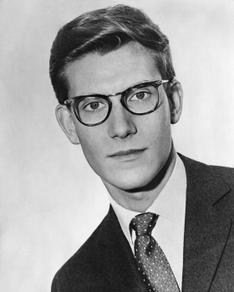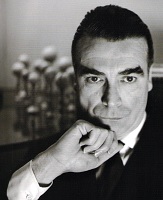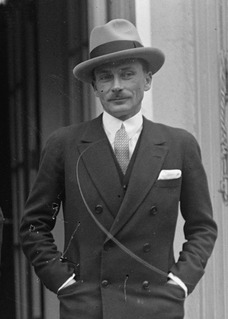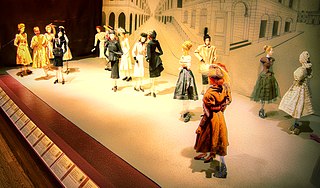Related Research Articles

Yves Henri Donat Mathieu-Saint-Laurent, referred to as Yves Saint-Laurent or YSL, was a French fashion designer who, in 1962, founded his eponymous fashion label. He is regarded as being among the foremost fashion designers of the twentieth century. In 1985, Caroline Milbank wrote, "The most consistently celebrated and influential designer of the past twenty-five years, Yves Saint Laurent can be credited with both spurring the couture's rise from its 1960s ashes and with finally rendering ready-to-wear reputable." He developed his style to accommodate the changes in fashion during that period. He approached his aesthetic from a different perspective by helping women find confidence by looking both comfortable and elegant at the same time. He is also credited with having introduced the "Le Smoking" tuxedo suit for women and was known for his use of non-European cultural references and of diverse models.

Christian Ernest Dior was a French fashion designer, best known as the founder of one of the world's top fashion houses Christian Dior SE, which is now owned by parent company LVMH. His fashion houses are known all around the world, specifically "on five continents in only a decade" (Sauer). Dior is the second child to a family of seven, born to Maurice Dior and Madeleine Martin, in the town of Granville.

Paul Poiret was a French fashion designer, a master couturier during the first two decades of the 20th century. He was the founder of his namesake haute couture house. His contributions to his field have been likened to Picasso's legacy in 20th-century art.

Cristóbal Balenciaga Eizaguirre was a Spanish fashion designer, and the founder of the Balenciaga fashion house. He had a reputation as a couturier of uncompromising standards and was referred to as "the master of us all" by Christian Dior and as "the only couturier in the truest sense of the word" by Coco Chanel, who continued, "The others are simply fashion designers". On the day of his death, in 1972, Women's Wear Daily ran the headline "The King is Dead".
Mainbocher is a fashion label founded by the American couturier Main Rousseau Bocher, also known as Mainbocher. Established in 1929, the house of Mainbocher successfully operated in Paris (1929–1939), and then in New York (1940–1971).

Lucien Lelong was a French couturier who was prominent from the 1920s to the 1940s.

Edward Henry Molyneux was a leading British fashion designer whose salon in Paris was in operation from 1919 until 1950. He was characterised as a modernist designer who played with the refinements of couture style, a modernist aesthetic, and the desire to be socially and culturally advanced.
Dominique Sirop is a French fashion designer and grand couturier.

Nina Ricci is a fashion house founded by Maria "Nina" Ricci and her son Robert in Paris in 1932, and owned by the Spanish beauty and fashion group Puig since 1998.
The Fédération française de la couture, du prêt-à-porter des couturiers et des créateurs de mode is the governing body for the French fashion industry. The Federation was created in 1973, growing out of an older trade association, the Chambre syndicale de la haute couture parisienne which was created in 1868. By the 1st of July 2017, the Federation removed its reference to French nationality for a more succinct title.

Harem pants or harem trousers are baggy, long pants caught in at the ankle. Early on, the style was also called a harem skirt. The original so-called 'harem pants/skirts' were introduced to Western fashion by designers such as Paul Poiret around 1910, although they themselves were inspired by Middle East styles, and by şalvar. The term 'harem pants' subsequently became popular in the West as a generic term for baggy trousers caught in at the ankle that suggest the Turkish style, or similar styles such as bloomers, the South Asian shalwar and patiala salwar; the Bosnian dimije; sirwal ; and the Ukrainian sharovary.

L'Officiel is a French fashion magazine with a USA edition. It has been published in Paris since 1921 and targets upper-income, educated women aged from 25 to 49. In 2006, it had a circulation of 101,719. A men's edition of L'Officiel, L'Officiel Hommes, and many foreign editions are also published. The complete name of the magazine is "L'Officiel de la couture et de la mode de Paris".

Haute couture refers to the creation of exclusive custom-fitted high-end fashion design that is constructed by hand from start-to-finish. Beginning in the mid-nineteenth century, Paris became the centre of a growing industry which focused on making outfits from high-quality, expensive, often unusual fabric and sewn with extreme attention to detail and finished by the most experienced and capable of sewers—often using time-consuming, hand-executed techniques. Couture translates literally from French as "dressmaking", sewing, or needlework and is also used as a common abbreviation of haute couture and can often refer to the same thing in spirit. Haute translates literally to "high". An haute couture garment is always made for an individual client, tailored specifically for the wearer's measurements and body stance. Considering the amount of time, money, and skill allotted to each completed piece, haute couture garments are also described as having no price tag: budget is not relevant. In modern France, haute couture is a protected name that may not be used except by firms that meet certain well-defined standards.

John Cavanagh was an Irish couturier of the 1950s and 1960s. A member of the Incorporated Society of London Fashion Designers (IncSoc), his style has been described as reflecting Parisian chic. He designed the wedding dresses for the Duchess of Kent in 1961 and for Princess Alexandra in 1963.

Théâtre de la Mode was a 1945–1946 touring exhibit of fashion mannequins created at approximately 1/3 the size of human scale, and crafted by top Paris fashion designers. It was created to raise funds for war survivors and to help revive the French fashion industry in the aftermath of World War II. The original Théâtre de la Mode exhibit toured Europe and then the United States, and is now part of the permanent collections of the Maryhill Museum of Art in Washington state in the United States.
Paul Deneve is a businessperson working in fashion and technology. In September 2013, he became a vice president at Apple. Before joining Apple, he was CEO of the fashion house Yves Saint Laurent (YSL), now a subsidiary of PPR. Between 1997 and 2013, he managed a number of companies in the luxury sector, such as Courreges, Nina Ricci, Lanvin and YSL.

Robert Piguet was a Swiss-born, Paris-based fashion designer who is mainly remembered for training Christian Dior and Hubert de Givenchy. The Piguet fashion house ran from 1933 to 1951; since then, the brand Robert Piguet has been associated exclusively with fragrances.

"Princess line" or "princess dress" describes a woman's fitted dress or other garment cut in long panels without a horizontal join or separation at the waist. Instead of relying on darts to shape the garment, the fit is achieved with long seams and shaped pattern pieces. A rarely used alternative name for the Princess line was French-dart-line dress.

Léo Marciano Paris is a French luxury fashion house founded in 1966 by the eponymous designer Léo Marciano.
References
- ↑ Pundir, Nirupama (2007). Fashion Technology: Today and Tomorrow. Mittal Publications. p. 22. ISBN 978-81-8324-203-5.